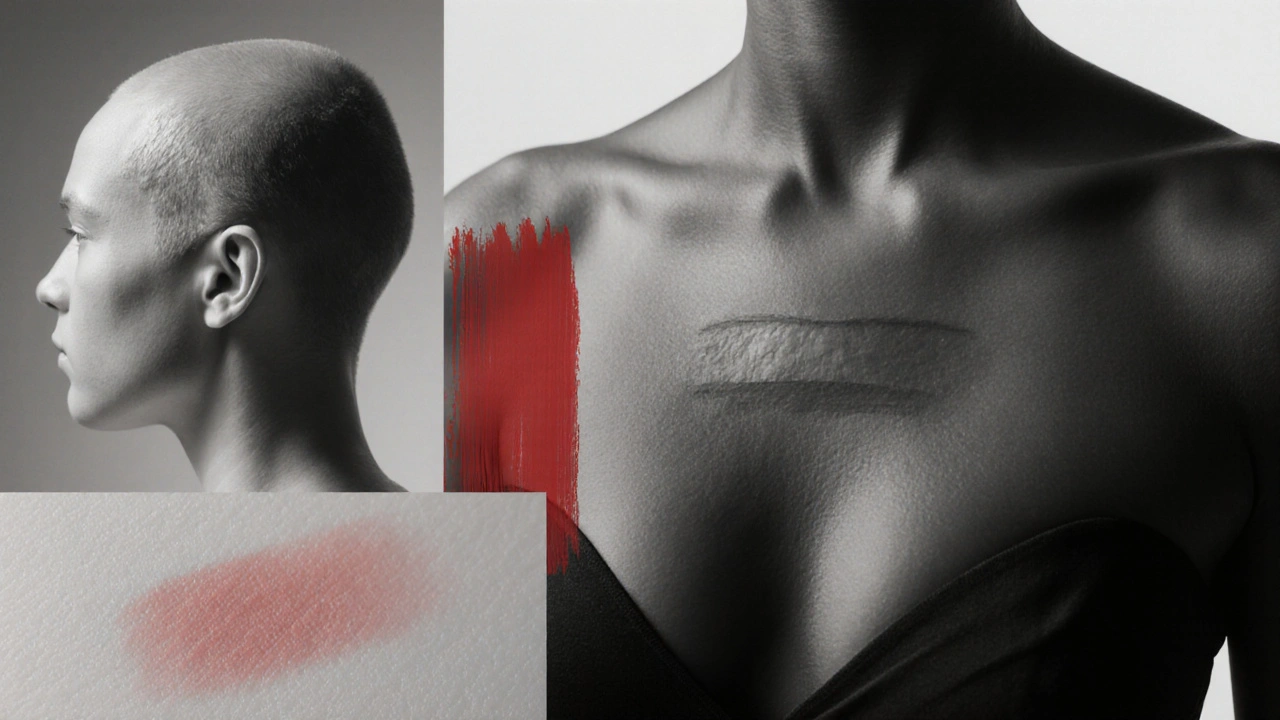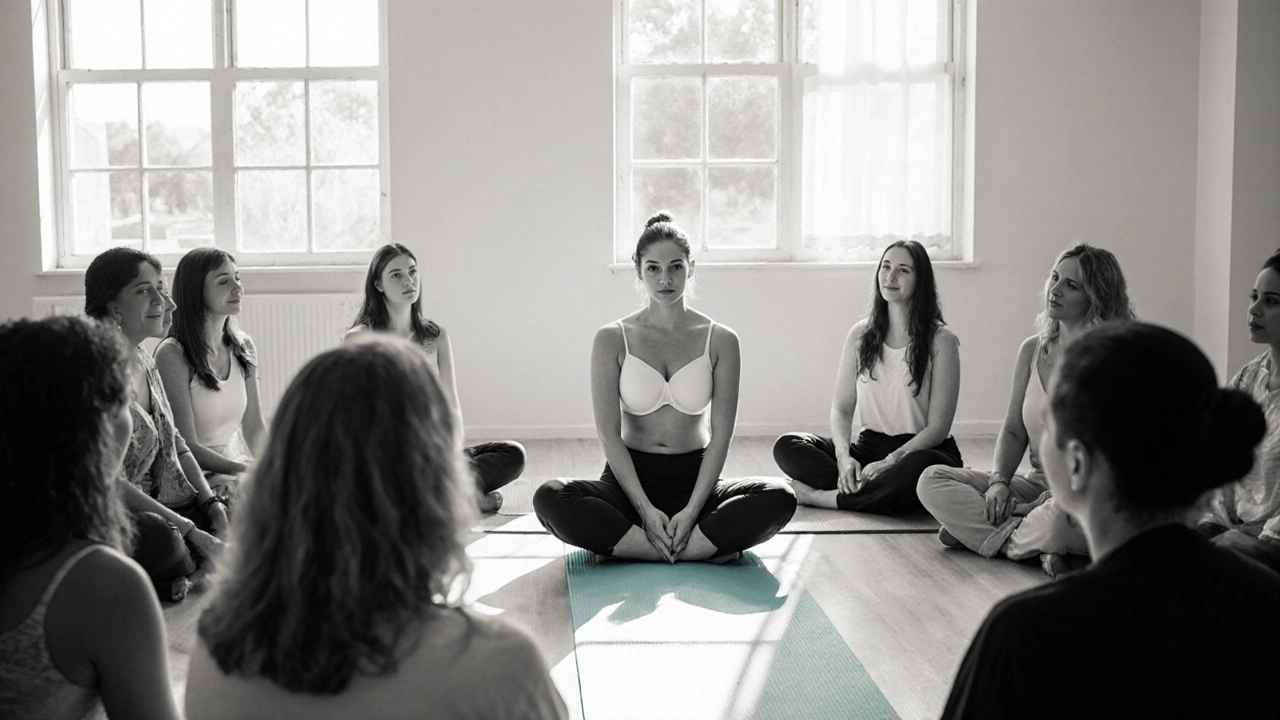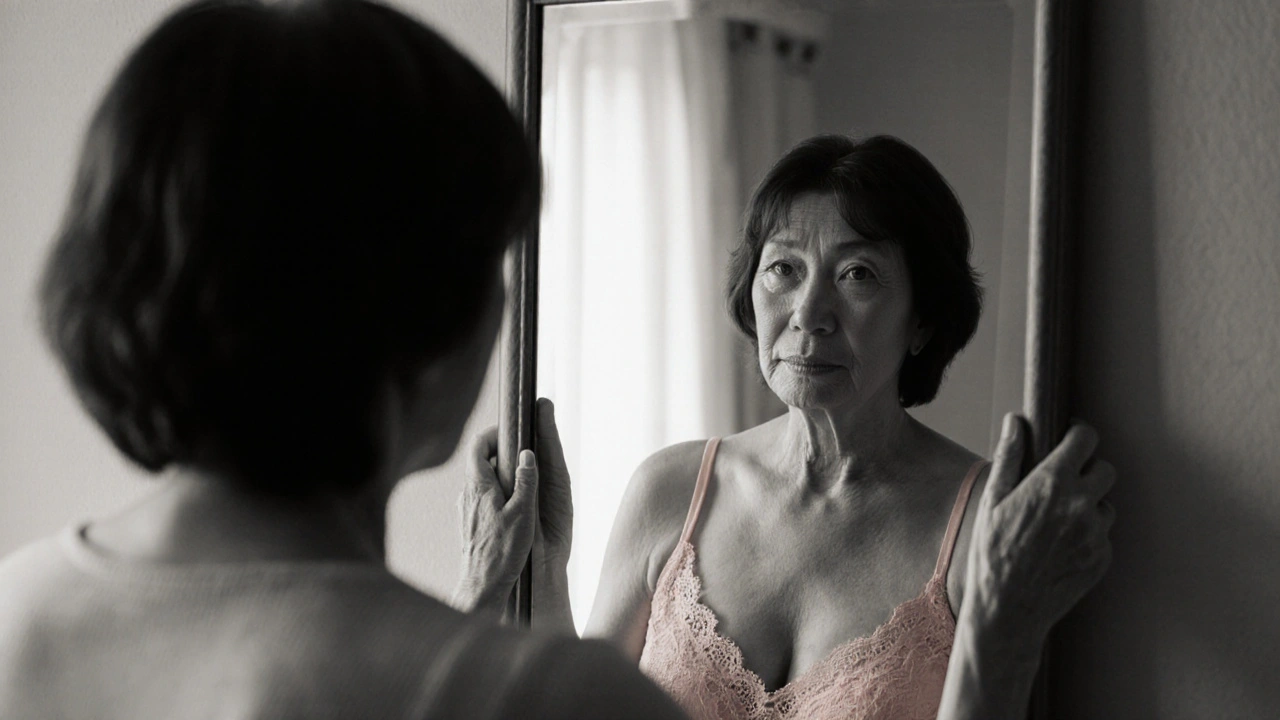Body Image Confidence Estimator
How your treatment choices may impact your confidence
This tool estimates how different treatment paths affect self-esteem based on UK research data. Your results are personalized and non-diagnostic.
Select your treatment path
Your Estimated Confidence Impact
Based on 2023 UK dataScale: 1 (lowest) to 5 (highest)
Personalized Recommendations
After treatment, focus on gentle movement and mindfulness practices. Many survivors find confidence through community connection and small victories in self-care.
When a breast cancer diagnosis hits, the medical battle often steals the spotlight, but the emotional fallout-especially changes to body image and self‑esteem-can linger much longer. Understanding why these feelings surface, how they differ across treatments, and what practical steps can soften the blow helps survivors reclaim confidence sooner rather than later.
What "body image" really means in a cancer journey
Body Image is the mental picture you hold of your own shape, looks, and physical abilities. For most people it’s a stable sense, but cancer can crack that mirror. Scars, hair loss, weight fluctuations, and altered breast contours all rewrite the story your brain tells itself.
Why self‑esteem takes a hit
Self‑Esteem refers to the overall value you assign to yourself as a person. When a disease forces you to wear a surgical bra, avoid swimsuits, or answer intrusive questions, the inner critic often turns up the volume. Studies from the UK Psycho‑Oncology Service show that up to 68% of women report lowered self‑worth during active treatment.
Key treatments and their impact on appearance
Each therapy leaves a distinct visual imprint. Knowing what to expect can reduce the surprise factor.
- Mastectomy: Complete removal of breast tissue. Scars can be long, and many women feel a sudden loss of femininity.
- Lumpectomy: Removes only the tumor and a small margin of healthy tissue, leaving most of the breast intact. Cosmetic changes are usually minor, but the surgical scar can still bother some.
- Chemotherapy: Often triggers hair loss, skin darkening, and weight gain or loss, all of which shift how you see your body.
- Radiotherapy: Can cause skin redness, fibrosis, and a stiff feeling around the treated area, sometimes making the breast feel “tight.”
- Hormonal therapy (e.g., Tamoxifen): May lead to menopausal symptoms such as hot flashes and altered body fat distribution.
Reconstruction options: Restoring shape, not just skin
When the goal is to soften the visual blow, reconstruction steps in. Here’s a quick rundown:
| Method | Typical Recovery Time | Scar Visibility | Self‑Esteem Impact (average rating 1‑5) |
|---|---|---|---|
| Implant‑Based | 3‑6 weeks | Moderate (incision line) | 4.2 |
| Autologous (flap) surgery | 6‑12 weeks | Low (donor site scar) | 4.6 |
| No reconstruction (prosthetic) | Immediate | Low (external bra) | 3.4 |
Numbers come from a 2023 UK Breast Reconstruction Survey, where participants rated how much reconstruction helped their confidence on a five‑point scale.

Psychological coping tools that actually work
Beyond the operating theatre, mental tools can rebuild the inner picture.
- Mindful body scanning: Spend five minutes each day focusing on sensations without judgment. It teaches the brain to accept change rather than fight it.
- Journaling: Write down moments when you felt proud of your body-whether you walked through a hospital corridor or simply tugged on a favorite dress.
- Therapy: A therapist trained in Psycho‑Oncology can map the link between scar perception and self‑worth, offering concrete reframes.
- Physical activity: Gentle yoga or swimming rebuilds muscle tone and gives a visual cue of strength, which feeds back into confidence.
Support networks: You don’t have to face the mirror alone
Connecting with others who understand the visual journey can shift perspective dramatically.
Support Groups-whether in‑person at a local cancer charity or online via platforms like Breast Cancer Care-provide a safe space to share scar stories, swap prosthetic tips, and celebrate tiny victories. A 2022 longitudinal study found that regular group attendance reduced self‑esteem scores by an average of 1.8 points on the Rosenberg Scale.
Practical checklist for navigating body‑image challenges
- Schedule a post‑surgery photo session within the first month; seeing yourself objectively helps track healing.
- Pick at least one outfit you love that accommodates your new shape-wear it before you feel ready.
- Research reconstruction options early; a clear plan reduces uncertainty.
- Ask your oncologist about skin‑care products that mitigate radiotherapy discoloration.
- Join a Support Group and attend at least two meetings in the first quarter.

Real‑world stories that illustrate change
Emma, a 42‑year‑old from Bristol, chose a mastectomy followed by implant reconstruction. She recalls staring at her scar for weeks, feeling “less like a woman.” After joining a local support circle, she began documenting her weekly progress with photos. Six months later, she said the mirror finally reflected “a survivor, not a patient.” Her confidence jump mirrored the 4.2 rating in the reconstruction table above.
Jasmine, 58, opted for a lumpectomy. Her main struggle wasn’t the scar but chemotherapy‑induced hair loss. She experimented with scarves and headbands, eventually turning her hair‑less days into a fashion statement that boosted her self‑esteem more than any surgical outcome could.
When to seek professional help
If feelings of shame, avoidance, or depression linger beyond six months, consider a referral to a mental‑health specialist. Look for professionals who list “breast cancer” or “oncology” in their expertise-these clinicians understand the nuanced link between physical change and identity.
Key takeaways
- Body image and self‑esteem are deeply intertwined with each breast‑cancer treatment’s visual side‑effects.
- Reconstruction can improve confidence, but it’s not a prerequisite for a positive self‑view.
- Mind‑body practices, therapy, and active support groups provide the most measurable boost in self‑esteem.
- Creating a practical, personalized checklist turns abstract worries into concrete actions.
Frequently Asked Questions
Can body‑image issues persist years after treatment?
Yes. Even after physical healing, the mental image can lag. Ongoing therapy or support groups can help re‑align perception years later.
Is reconstruction necessary for regaining self‑esteem?
Not always. Some women find confidence through clothing choices, yoga, or community advocacy without surgery. It’s a personal decision.
How soon after mastectomy can I join a support group?
Most groups welcome members at any stage. Early participation can provide emotional anchors during the recovery weeks.
What are some low‑cost ways to boost body confidence?
Try home‑based yoga, free online fashion tutorials for post‑surgery dressing, and journaling prompts that focus on what your body can do, not just how it looks.
Does chemotherapy affect skin tone permanently?
Temporary darkening is common, but most patients see improvement within months. Gentle sunscreen and dermatologist‑approved creams can speed recovery.

Dervla Rooney
October 15, 2025 AT 13:07I completely understand how a breast cancer diagnosis can upend one’s self‑image. The physical changes you describe-scars, hair loss, altered contours-are real and often painful to accept. It helps to treat your body like an ally, reminding yourself daily of what it has endured and achieved. Simple practices such as mindful body scanning or journaling can gradually rebuild a kinder internal narrative. Over time, many survivors report a renewed sense of confidence that surpasses the pre‑diagnosis baseline.
Crystal Newgen
October 17, 2025 AT 23:27It’s amazing how sharing a favorite outfit early on can make a huge difference. Wearing something that makes you feel good, even if it’s just a loose‑fit tee, can shift your perception of the changed body.
Lisa Emilie Ness
October 20, 2025 AT 09:47Support groups matter.
Emily Wagner
October 22, 2025 AT 20:07From a phenomenological standpoint, the body is not merely a vessel but a lived experience, a narrative that persists beyond tissue alteration. When chemotherapy induces alopecia, the visual loss triggers a metaphoric void, yet the embodied intelligence remains resilient. Engaging in reflective journaling serves as a hermeneutic tool, translating scar and hair loss into symbols of survival. In parallel, gentle yoga re‑establishes proprioceptive feedback, reinforcing the mind‑body axis. Thus, the dialectic between external change and internal continuity can be negotiated through deliberate practice.
Daylon Knight
October 25, 2025 AT 06:27Oh great, another guide on feeling "confident" after your chest gets remodeled. Like we needed more pep talks, right? At least the sarcasm is free.
Mary Cautionary
October 27, 2025 AT 15:47One must acknowledge the epistemic gravity of post‑oncologic aesthetic concerns. The sociocultural construct of femininity exerts a palpable pressure upon the survivor, compelling a recalibration of self‑valuation. Empirical data, such as the cited UK Psycho‑Oncology Service statistics, corroborate the prevalence of diminished self‑esteem. Yet, the recourse to reconstructive surgery, while statistically beneficial, remains an elective interlocutor within a broader ontological discourse. Consequently, a nuanced appreciation of both psychosocial and corporeal dimensions is essential.
Mark French
October 30, 2025 AT 02:07While I definitly see the value in the practical checklist, I would also sugggest integrating regular mental health screenings. A structured approach helps ensure that emotional wellbeing is not overlooked during the physical recovery phases. Persistent feelings of shame or avoidance merit professional evaluation, as they can evolve into more serious conditions if left unchecked.
Cynthia Petersen
November 1, 2025 AT 12:27It’s encouraging to see such a thorough breakdown-so many resources packed into one post. Of course, if you’re still checking the mirror every five minutes, that’s just… adorable. Keep experimenting with those scarves; the world needs more runway‑ready survivors.
Ellie Hartman
November 3, 2025 AT 22:47These strategies feel really inclusive and doable. I especially like the suggestion to schedule a photo session early on; it can demystify the healing process. Remember, you’re not alone on this journey, and every small step counts.
Johnny Ha
November 6, 2025 AT 09:07Look, the mainstream media won’t tell you this, but they’re hiding the truth about the “miracle” implants. They’re all part of a larger agenda to keep us compliant. The real cure is out there, just not on the usual channels.
Julie Gray
November 8, 2025 AT 19:27One must consider that the very protocols we accept may be under clandestine influence, orchestrated by vested interests. The sanitized language of reconstruction masks a deeper sociopolitical stratagem. It is imperative to remain vigilant.
Hannah Dawson
November 11, 2025 AT 05:47The data points you cite are intriguing, yet they omit the cost‑benefit analysis of long‑term psychosocial outcomes. Moreover, the sample size appears limited, which could skew the perceived efficacy of support groups. A more rigorous meta‑analysis would be advisable.
Jason Layne
November 13, 2025 AT 16:07Don’t be fooled by the “nice‑guys” pushing the mainstream narrative – it’s all a controlled experiment. Wake up and question everything.
AnGeL Zamorano Orozco
November 16, 2025 AT 02:27When the lights dim in the operating theatre and the world’s hum fades into the sterile echo of machines, a quiet drama unfolds within the very marrow of our being. The surgeon’s scalpel does not merely carve flesh; it etches a story upon our skin, a tale of survival that the mirror later reflects with bruised reverence. Each scar, a stanza, each stitch, a comma in the long, winding poem of resilience. We stand before the glass, wondering if the woman staring back is the one who walked in, or a phantom forged by hormone storms and chemotherapy’s relentless tide. The hair that once cascaded like a river now lies hidden beneath scarves, a silent protest against the capricious whims of disease. Yet, in that very concealment, a new kind of fashion emerges, bold and unapologetic, turning loss into avant‑garde statement. The reconstruction, whether implant‑based or autologous, is not a mere restoration of form but an act of defiance against the narrative that illness defines us. It is a declaration that flesh can be reshaped without surrendering spirit. As we engage in mindful body scanning, we learn to hear the whisper of each muscle, the sigh of each tendon, celebrating function over façade. Journaling becomes a chronicle of victories, each entry a brick in the fortress of self‑esteem. Therapy, often dismissed as ancillary, serves as the invisible scaffolding supporting this edifice of confidence. Physical activity, be it yoga’s graceful flow or swimming’s buoyant dance, re‑writes the script, proving that strength resides not just in size but in motion. Support groups echo with shared stories, turning solitary whispers into a chorus of triumph that reverberates far beyond the clinic walls. In the end, the true reconstruction is internal; the outward shape is but a mirror reflecting a soul that has endured, adapted, and ultimately, flourished.
Victoria Unikel
November 18, 2025 AT 12:47Feeling weird about the whole thing, but I’ll try.
John Petter
November 20, 2025 AT 23:07One must appreciate the nuanced interdependence of psychosomatic variables. The discourse, while comprehensive, could benefit from a more refined lexical palette.